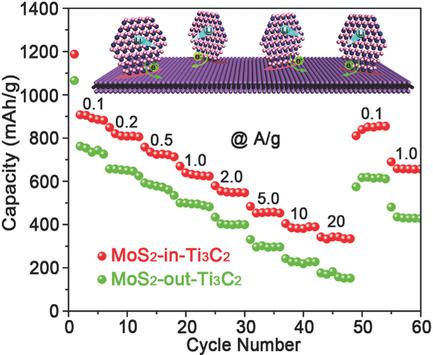当前位置:
X-MOL 学术
›
Adv. Funct. Mater.
›
论文详情
Our official English website, www.x-mol.net, welcomes your
feedback! (Note: you will need to create a separate account there.)
2D Nanospace Confined Synthesis of Pseudocapacitance‐Dominated MoS2‐in‐Ti3C2 Superstructure for Ultrafast and Stable Li/Na‐Ion Batteries
Advanced Functional Materials ( IF 18.5 ) Pub Date : 2018-08-13 , DOI: 10.1002/adfm.201804306 Kun Ma 1 , Hao Jiang 1 , Yanjie Hu 1 , Chunzhong Li 1
Advanced Functional Materials ( IF 18.5 ) Pub Date : 2018-08-13 , DOI: 10.1002/adfm.201804306 Kun Ma 1 , Hao Jiang 1 , Yanjie Hu 1 , Chunzhong Li 1
Affiliation

|
Exploring a universal strategy to implement the precise control of 2D nanomaterials in size and layer number is a big challenge for achieving ultrafast and stable Li/Na‐ion batteries. Herein, the confined synthesis of 1–3 layered MoS2 nanocrystals into 2D Ti3C2 interlayer nanospace with the help of electrostatic attraction and subsequent cetyltrimethyl ammonium bromide (CTAB) directed growth is reported. The MoS2 nanocrystals are tightly anchored into the interlayer by 2D confinement effect and strong MoC covalent bond. Impressively, the disappearance of Li+ intercalated into MoS2 reduction peak is successfully observed for the first time in the experiment, showing in a typical surface‐controlled charge storage behavior. The pseudocapacitance‐dominated contribution guarantees a much faster and more stable Li/Na storage performance. As predicted, this electrode exhibits a very high Li+ storage capacity of 340 mAh g−1 even at 20 A g−1 and a long cycle life (>1000 times). It also shows an excellent Na+ storage capacity of 310 mAh g−1 at 1 A g−1 with a 1600 times high‐rate cycling. Such impressive confined synthesis strategy can be extended to the precise control of other 2D nanomaterials.
中文翻译:

伪电容主导的MoS2-in-Ti3C2上层结构的二维纳米空间受限合成,用于超快和稳定的锂/钠离子电池
探索实现二维纳米材料的尺寸和层数精确控制的通用策略,对于实现超快速和稳定的锂/钠离子电池来说是一个巨大的挑战。本文报道了借助静电吸引和随后的十六烷基三甲基溴化铵(CTAB)定向生长将1-3层MoS 2纳米晶体限制合成为2D Ti 3 C 2层间纳米空间的报道。MoS 2纳米晶体通过2D约束效应和强大的MoC共价键牢固地锚定在中间层中。令人印象深刻的是,Li +的消失嵌入了MoS 2中首次在实验中成功观察到还原峰,表现出典型的表面控制电荷存储行为。伪电容为主的贡献可确保更快,更稳定的Li / Na存储性能。如预测的那样,该电极即使在20 A g -1的条件下也表现出非常高的340 mAh g -1的Li +储存容量,并且循环寿命长(> 1000倍)。它还显示出在1 A g -1下具有310 mAh g -1的出色的Na +存储容量,并具有1600倍的高循环率。这种令人印象深刻的受限合成策略可以扩展到其他2D纳米材料的精确控制。
更新日期:2018-08-13
中文翻译:

伪电容主导的MoS2-in-Ti3C2上层结构的二维纳米空间受限合成,用于超快和稳定的锂/钠离子电池
探索实现二维纳米材料的尺寸和层数精确控制的通用策略,对于实现超快速和稳定的锂/钠离子电池来说是一个巨大的挑战。本文报道了借助静电吸引和随后的十六烷基三甲基溴化铵(CTAB)定向生长将1-3层MoS 2纳米晶体限制合成为2D Ti 3 C 2层间纳米空间的报道。MoS 2纳米晶体通过2D约束效应和强大的MoC共价键牢固地锚定在中间层中。令人印象深刻的是,Li +的消失嵌入了MoS 2中首次在实验中成功观察到还原峰,表现出典型的表面控制电荷存储行为。伪电容为主的贡献可确保更快,更稳定的Li / Na存储性能。如预测的那样,该电极即使在20 A g -1的条件下也表现出非常高的340 mAh g -1的Li +储存容量,并且循环寿命长(> 1000倍)。它还显示出在1 A g -1下具有310 mAh g -1的出色的Na +存储容量,并具有1600倍的高循环率。这种令人印象深刻的受限合成策略可以扩展到其他2D纳米材料的精确控制。


















































 京公网安备 11010802027423号
京公网安备 11010802027423号